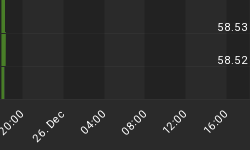The following update was presented on January 19th, for the benefit of subscribers.
One fault with Elliott Wave if considered a fault is that price objectives can be reached quicker than anticipated. When small indices such as the HUI are examined, slapping an Elliott Wave count onto it can be rather difficult. Such a small representation of the global indices can cause prices to move rather quickly, so there MUST be some allowance for the behaviour and structure of patterns. I would be the first to admit flaws with the counts presented below, but as described in "The Technical Palette" written in September 2006, using Frame Shift Analysis aids in determination of the correct reading frame of a selected section of chart within surrounding wave structures. By providing a realistic balance with wave structures, a somewhat accurate road map can be painted to guide the investor for where things stand in the big picture.
I decided to keep this web update brief and to the point, so three other charts with various technical indicators used to help mold the Elliott Wave count are not presented.
The mid-term Elliott Wave chart of the HUI is shown below, with the thought pattern denoted in green. Last week I had the upper move illustrating a rising wedge that required prices to continue going to support the structure. The pattern obviously collapsed and the HUI is now following a somewhat similar pattern as the XOI. This decline prompted the alternate count become the preferred count due to changes in elements of the pattern. Wave [2] is not likely to be much of a running correction compared to the higher Degree count, but the amount of time thus far is approaching three times that of wave [1]. Likely, there is at least 4-8 weeks of further consolidation in wave (Y) that is either going to be a flat (3-3-5) or a non-limiting triangle structure (3-3-3-3-3). If this count is correct, wave [3].III should last for approximately 3-4 months; so if wave [2].III finishes in early March, wave [3].III is set to terminate in late May/ early June 2008. Assuming wave [4].III lasts until late October 2008, then wave [5].V has the potential to run until the Fib target date of January 30th, 2009. One important thing to note is that in 2003, the HUI topped in December while the junior and exploration stocks continued an upward climb until March 2009. There would represent a 5 year difference between major tops, so if this holds, then it will be recommended to exit junior stocks around February/March 2009. (Note: Wave (W).[2] also can be counted as a diametric triangle (7 legs)).
Figure 1
The long-term Elliott Wave chart of the HUI is shown below, with the thought pattern denoted in green. One important thing to note about Elliott Wave is that short-term patterns may vary but the larger term trend should be well defined. In 2003 at some point (some time ago so I do not remember the exact date), I put up a chart showing "You are Here" for the HUI, which defined a running correction scenario, with a parabolic move in wave III that would follow all the way to the end of the bull market. Previously mentioned targets for wave III are between 1000-1300, depending upon how strong the market advances. Beyond wave III, it will be recommended to shift 70% of remaining profits into gold bullion and the remaining 30% into speculative stocks. Wave V will see any stock with the word "gold" go to the moon, so stocks that have the potential to host a 4-10 million ounce deposit will perform best. It will be irrelevant that a mine takes 7-10 years to be built, as people will be simply looking for gold companies to expand their reserves. Peak oil is going to seriously play into how much gold and silver can actually be mined, but the Johnny and Jane Come-Lately are going to be blinded by the shine of gold and not even see this coming. The termination of this bull market will see stocks fall off a cliff because this will be the end game for stocks.
Figure 2
This is a taster for the type of analysis I do at www.treasurechests.info. For further viewing of prior work, simply click on the Archive section of this site. I update the AMEX Gold BUGS Index, AMEX Oil Index, US Dollar Index, 10-Year US Treasury Index, S&P 500 Index as well as commentary on market-related issues and new technical analysis findings. Recently, the TNX had positive reversal that failed and has had a significant decline since then. The S&P also had a positive reversal with a measured move to 1612 fail and it was hypothesized the downside move should equal the upside potential, which lies just above 1200 (this is the minimum downside target). A future article will be written about this idea along with 2-3 different editorials, so there will be no updates for the HUI for some time. We follow some 60 stocks, with a focus on core positions and stocks that actually make up our personal portfolio. As well, the keeper of the site, Captain Hook writes 3-4 articles per week discussing macro issues, ratio analysis of various markets and an in-depth study of put/call ratios and shorting candidates.
Have a good day.
















